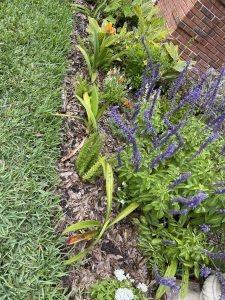
Everything bloomed later this year, didn’t it? Those 3 – 4 days of frost delayed everything in our Jacksonville gardens, though many blooms have been well worth the wait. Who knew that bromeliads were frost resistant? My blue sage’s buds froze, but the bromeliads, gingers, and hydrangeas have been better than ever.
All of this “new” timing has fried my memory on how to handle bulbs in our Duval County gardens. <Do we cut them back, down, divide, what?> My amaryllis have finished; the agapanthus are just getting underway. Bigger, bolder and more beauteous than I remember…though, I might say that every year? (See side note on some agapanthus MGV Candace Barone was looking after in a Deerwood garden.)
The topic reminded me of a Q&A Master Gardener Paula Weatherby took back in 2016 for the Daily Record.
Amaryllis
Question: What do I do with my amaryllis now that the flowers have faded? They’re pretty ratty. Some of the stalks have green bulbous growths at the top, and others don’t. Should I cut them off?
[Here’s Paula]
From glorious to gory. The story of amaryllis flowers when they’re done.
Amaryllis is one of a handful of flowering bulbs that do well in Florida. Gardeners from the north know them as holiday flowers, but Florida gardeners grow them outdoors and see them as true harbingers of spring.
And when they’re done flowering, they look awful.
The word “bulb” is used to refer to plants that have underground, fleshy nutrient and moisture storing structures. They have a period of growth and flowering, and then go through a necessary dormant period.
When the blooms fade, remove the flower stalks, leaving 1 to 2 inches of stalk above the bulb. Don’t damage the foliage, which remains on the plant most of the year. The leaves make food which the plant stores in the bulb to replenish what was used during flowering. It will be needed for next flowering season. When seed pods are left on the stalk, the plant uses its food to support seed production instead of storing it.
Besides, removing the stalks just makes the whole bed look tidier.
If you want to try your hand at growing new plants from your amaryllis seeds, pick the pods as soon as they turn yellow and split open. Place the black, papery seeds in pots or flats containing a well-drained medium. Lightly cover the seeds with additional medium and keep them in partial shade until they germinate. Gradually increase the amount of light they receive until they are in full sun. Fertilize with a half-strength liquid fertilizer solution every other week. Seedlings are ready for planting in the garden after a year.
But be forewarned. Seeds don’t always produce plants similar to their parents and will take several years before they bloom.
Dr. Sydney Brown & Dr. Robert Black authored “Amaryllis”, a very detailed guide for home gardeners and available at http://edis.ifas.ufl.edu/pdffiles/EP/EP06000.pdf.
Agapanthus
Th e huge, bulbous African lily that we grow here in Florida, as do some folks in southern Texas, California, the lower quadrant of Arizona and bits of Louisiana. Mostly blue, they often look white in the first bud, and you’re the envy of many if you’ve got a white one. Happiest in full sun, they will tolerate partial shade and like moist rich soil.
e huge, bulbous African lily that we grow here in Florida, as do some folks in southern Texas, California, the lower quadrant of Arizona and bits of Louisiana. Mostly blue, they often look white in the first bud, and you’re the envy of many if you’ve got a white one. Happiest in full sun, they will tolerate partial shade and like moist rich soil.
The trick with these is to pack them in. The tighter they sit together the better they bloom. Thus, they are effective in pots. A solo plant, in it’s first year in a flower border with lots of space may not bloom during that first May until they are more settled and bigger the following year.
Supposedly they’re deer resistant. However, as MGV Candace Barone found out last year, the deer do not know that. Seeing a massive bed of lush, colorful blooms they set upon them, and spat them all out. Bleak stems remained in stoic, soldierly misery just in time for a Memorial Day neighborhood picnic.
UF recommends pairing a cluster of agapanthus with Dark green and/or burgundy foliage so as to highlight the clusters of blue flowers and soft green of the leaves. Pinks and corals also work well, as floral companions.
Once the plant has finished blooming, you can take off the faded petals, and if the plant has been pollinated, there will be seed heads developing. Snip those off and let dry out on a sunny windowsill and you should have viable seeds shortly. With the stem, trim to about 1″ above the nexus, so that the plant can focus all of its energy into nutrifying the bulb and root system. Leave the foliage. BUT, very important, label it. Once bloomed, the foliage looks exactly like the amaryllis. You think you will remember. When you start moving things around in the Fall, you’ll be amazed how confusing it can get…and it’s not your fault. They’re both from the same family — Amaryllidaceae. (as are crinums, snowdrops and rain lilies.)
—
This post was written by Juliet Johnson, MGV-Duval with assistance from Paula Weatherby and Candace Barone.
 0
0


